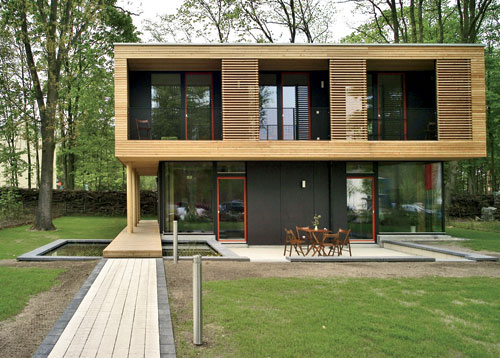Low Energy, but High Impact
Letting in the light
Until recently, superinsulated buildings often had very small and very few windows, since glazing can be a significant source of heat loss. But advances in window technology have fostered the production of triple-glazed units with very low U-values (the U-value is the inverse of the R-value and describes how well a building element conducts heat). Triple-glazed units with U-values as low as 0.09 - a level unimaginable just a few years ago - are now readily available in Europe. A few North American manufacturers also make windows that meet Passive House-recommended U-values of 0.14 or less.
Swiss-born architect Tim Eian, who practices on both sides of the Atlantic, asserts that the lapse in U.S. development gave Europe a generous head start in Passive House-related technologies. By now, Europe has much greater momentum, with more than 15,000 certified projects, compared with a handful in North America.
But the relationship between the continents is a symbiotic one. To facilitate high insulation levels, many European architects are turning to American wood-frame construction, using engineered-wood joists to create deeper wall cavities. Such is the case for the Dorfen, Germany-based Architekturwerkstatt Vallentin. Principals Gernot and Rena Vallentin have decided to limit their practice to Passive House designs.
 |
Along with the intelligent positioning of overhanging balconies and wood screens, which serve as shading devices, recent advances in window technology allowed Vallentin to glaze significant portions of the south facade of a Passive House in Berlin. Photo: courtesy Architekturewerkstatt Vallentin |
Â
A common criticism is that the standard's requirements push houses to be compact and somewhat "boxy." The Vallentins combat this tendency with subtle variations of form, color, texture, and materials. On the interior of their house in Lengdorf they take advantage of double-height spaces and carefully place windows to provide a feeling of spaciousness and balanced daylighting.
Not all Europeans are so gung ho about the system, however. German architect and structural engineer Werner Sobek advocates energy-efficient buildings that rely on active technology, allowing them to be more open and responsive to the environment. He also criticizes the Passive House standard for not considering the embodied energy in elements such as rigid insulation.
Climate adaptations
Feist initially pushed the idea of relying solely on internal gains and the HRV to heat the buildings - a viable strategy in Germany's relatively mild climate. But the United States has much more regional variation with temperature and humidity extremes. The steamy South presents one of the most difficult challenges. While the BriggsKnowles project in Maine can rely on its ERV for cooling, a project in a predominantly hot and humid climate requires a different approach. For his own Lafayette, Louisiana, Passive House residence completed last year, architect Corey Saft used superinsulation and passive techniques to reduce heat gain.









